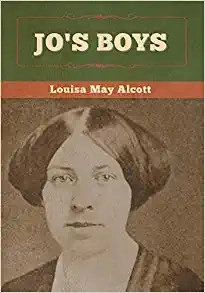Reading Level
What is the reading level of Jo's Boys?
Analysing the books in the series, we estimate that the reading level of Jo's Boys is 6th and 7th grade. Readers on Amazon consider it readable at 3 - 7 Grade Level.
What is the Lexile Measure of Jo's Boys?
A popular method used by schools to measure a student reader’s ability is Lexile level or a Lexile Measure. The Lexile Level of Jo's Boys is 1120L .
What age is Jo's Boys suitable for ?
Readers of age 9 - 12 years will enjoy Jo's Boys.
Expert Readability Tests for
Jo's Boys
| Readability Test | Reading Level |
|---|---|
| Flesch Kincaid Scale | Grade 7 |
| SMOG Index | Grade 10 |
| Coleman Liau Index | Grade 16 |
| Dale Chall Readability Score | Grade 7 |
Reading Time
6 hrs 17 mins
How long to read Jo's Boys?
The estimated word count of Jo's Boys is 94,240 words.
A person reading at the average speed of 250 words/min, will finish the book in 6 hrs 17 mins. At a slower speed of 150 words/min, they will finish it in 10 hrs 29 mins. At a faster speed of 450 words/min, they will finish it in 3 hrs 30 mins.
| Jo's Boys - 94,240 words | ||
|---|---|---|
| Reading Speed | Time to Read | |
| Slow | 150 words/min | 10 hrs 29 mins |
| Average | 250 words/min | 6 hrs 17 mins |
| Fast | 450 words/min | 3 hrs 30 mins |
- Authors
More about Jo's Boys
94,240 words
Word Count
for Jo's Boys
220 pages
Pages
10 hours and 8 minutes
Audiobook length
Description
Louisa May Alcott (November 29, 1832 – March 6, 1888) was an American novelist. She is best known for the novel Little Women, set in the Alcott family home, Orchard House in Concord, Massachusetts, and published in 1868. This novel is loosely based on her childhood experiences with her three sisters.Alcott was the daughter of noted transcendentalist and educator Amos Bronson Alcott and Abigail May Alcott. Alcott's early education included lessons from the naturalist Henry David Thoreau. She received the majority of her schooling from her father. She received some instruction also from writers and educators such as Ralph Waldo Emerson, Nathaniel Hawthorne, and Margaret Fuller, who were all family friends. She later described these early years in a newspaper sketch entitled "Transcendental Wild Oats." The sketch was reprinted in the volume Silver Pitchers (1876), which relates the family's experiment in "plain living and high thinking" at Fruitlands.As an adult, Alcott was an abolitionist and a feminist. In 1847, the family housed a fugitive slave for one week. In 1848, Alcott read and admired the "Declaration of Sentiments" published by the Seneca Falls Convention on women's rights.Poverty made it necessary for Alcott to go to work at an early age as an occasional teacher, seamstress, governess, domestic helper, and writer. Her first book was Flower Fables (1849), a selection of tales originally written for Ellen Emerson, daughter of Ralph Waldo Emerson. In 1860, Alcott began writing for the Atlantic Monthly. When the American Civil War broke out, she served as a nurse in the Union Hospital at Georgetown, D.C., for six weeks in 1862-1863. Her letters home – revised and published in the Commonwealth and collected as Hospital Sketches (1863, republished with additions in 1869) – garnered her first critical recognition for her observations and humor. Her novel Moods (1864), based on her own experience, was also promising.She also wrote passionate, fiery novels and sensational stories under the nom de plume A. M. Barnard. Among these are A Long Fatal Love Chase and Pauline's Passion and Punishment. Her protagonists for these tales are willful and relentless in their pursuit of their own aims, which often include revenge on those who have humiliated or thwarted them. Written in a style which was wildly popular at the time, these works achieved immediate commercial success. (Wikipedia.org) Read more
